Military Insignia Designations
Throughout time military men have prided themselves individually and with an association to the group of men they have served. Whether it be individual knights bearing their personalized shield or an individual unit marking, specific designations have been used to reflect this pride
Heraldry is the profession, study, or art of creating, granting, and blazoning arms and ruling on questions of rank or protocol, as exercised by an officer of arms. An officer of arms is a person appointed by a sovereign or state with authority to perform one or more of the following functions: to control and initiate armorial matters, arrange and participate in ceremonies of state, and to conserve and interpret eraldic and genealogical records. Traditionally, officers of arms are of three ranks: kings of arms, heralds of arms, and pursuivants of arms. Officers of arms whose appointments are of a permanent nature are known as officers of arms in ordinary; those whose appointments are of a temporary or occasional nature are known as officers of arms extraordinary. The origins of heraldry lie in the need to distinguish participants in combat when their faces were hidden by iron and steel helmets. Eventually a formal system of rules developed into ever more complex forms of heraldry.
There are various conjectures as to the origins of heraldic arms. As early as predynastic Egypt, an emblem known as a "serekh" was used to indicate the extent of influence of a particular regime, sometimes carved on ivory labels attached to trade goods, but also used to identify military allegiances and in a variety of other ways. It led to the development of the earliest hieroglyphs. This practice seems to have grown out of the use of animal mascots, whose pelts or bodies were literally affixed to staves or standards of the period. Some of the oldest "serekhs" consist of a striped or cross-hatched box, representing a palace or city, with a crane, scorpion, or other animal drawn standing on top. Before long, a falcon representing Horus became the norm as the animal on top, with the individual Pharaoh's symbol usually appearing in the box beneath the falcon, and above the stripes representing the palace. Ancient warriors often decorated their shields with patterns and mythological motifs. These symbols could be used to identify the warriors when their faces were obscured by helmets. Army units of the Roman Empire were identified by the distinctive markings on their shields. These were not heraldic in the medieval and modern sense, as they were associated with units, not individuals or families. Ancient warriors often decorated their shields with patterns and mythological motifs. These symbols could be used to identify the warriors when their faces were obscured by helmets. Army units of the Roman Empire were identified by the distinctive markings on their shields. These were not heraldic in the medieval and modern sense, as they were associated with units, not individuals or families.
The seeds of heraldic structure in personal identification can be detected in the account in a contemporary chronicle of Henry I of England, on the occasion of his knighting his son-in-law Geoffrey V, Count of Anjou, in 1127. He placed to hang around his neck a shield painted with golden lions. The funerary enamel of Geoffrey (died 1151), dressed in blue and gold and bearing his blue shield emblazoned with gold lions, is the first recorded depiction of a coat of arms. By the middle of the 12th century, coats of arms were being inherited by the children of armigers (persons entitled to use a coat of arms) across Europe.
Between 1135 and 1155, seals representing the generalized figure of the owner attest to the general adoption of heraldic devices in England, France, Germany, Spain, and Italy. By the end of the century, heraldry appears as the sole device on seals. In England, the practice of using marks of cadency arose to distinguish one son from another; it was institutionalized and standardized by John Writhe in the early 15th century. In the late Middle Ages and the Renaissance, heraldry became a highly developed discipline, regulated by professional officers of arms. As its use in jousting became obsolete, coats of arms remained popular for visually identifying a person in other ways eg: impressig in sealing wax on documents, carving on family tombs, and flying as a banner on country homes. The first work of heraldic jurisprudence, De Insigniis et Armis, was written in the 1350s by Bartolus de Saxoferrato, a professor of law at the University of Padua.
From the beginning of heraldry, coats of arms have been executed in a wide variety of media, including on paper, painted wood, embroidery, enamel, stonework and stained glass. For the purpose of quick identification in all of these, heraldry distinguishes only seven basic colors and makes no fine distinctions in the precise size or placement of charges on the field. Coats of arms and their accessories are described in a concise jargon called blazon. This technical description of a coat of arms is the standard that is adhered to no matter what artistic interpretations may be made in a particular depiction of the arms. The specific meaning of each element of a coat of arms is subjective. Though the original armiger (owner) may have placed particular meaning on a charge, these meanings are not necessarily retained from generation to generation. Unless canting arms incorporate an obvious pun on the bearer's name, it may be difficult to find meaning in them. As changes in military technology and tactics made plate armour obsolete, heraldry became detached from its original function. This brought about the development of "paper heraldry" under the Tudors. Designs and shields became more elaborate at the expense of clarity. During the 19th century, especially in Germany, many coats of arms were designed to depict a natural landscape, including several charges tinctured "proper" (i.e. the way they appear in nature). This form has been termed "Landscape heraldry". Click on this link for and in depth description of the The rules of heraldry. Though heraldry is nearly 900 years old, it is still very much in use. Many cities and towns in Europe and around the world still make use of arms. Personal heraldry, both legally protected and lawfully assumed, has continued to be used around the world. Heraldic societies exist to promote education and understanding about the subject.
1st Infantry Regiment Coat of Arms
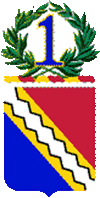
Heraldic information for a Coat of Arms begins with the "Blazon". To "blazon" arms means to describe them using the formal language of heraldry. This language has its own vocabulary and syntax, or rules governing word order, which becomes essential for comprehension when blasoning a complex coat of arms. The verb is a derivative of the French "blason" meaning "shield." The system of blazoning arms used in English-speaking countries today was developed by heraldic officers in the Middle Ages. The blazon includes a description of the armourials contained within the escutcheon or shield, the crest, supporters where present, motto and other insignia. Complex rules apply to the physical and artistic form of new creations of arms. A thorough understanding of these rules is a key to the art of heraldry (See "Rules of Heraldry" link above). In Europe originally the rules and terminology were broadly similar from kingdom to kingdom, but several national styles had developed by the end of the Middle Ages. Most aspects, however, remain in common.
The Blazon for the 1st Infantry Regiment Coat of Arms is as follows:
Shield: Per bend Gules and Azure, on a bend or a bendlet Argent indented of seven and counter indented of the same fimbriated Sable.
Crest: On a wreath of the colors Or and Gules the Arabic numeral "1" Azure fimbriated Or within a garland of laurel Vert.
Make sense? The rest of the description will be a little easier to understand.
Motto: SEMPER PRIMUS (Always First).
Symbolism
1. The regiment was organized in 1791 as the 2nd Infantry.
2. In 1792 it was designated as the Infantry of the 2nd Sub-legion.
3. In 1796 it was again designated as the 2nd Infantry.
4. In the consolidation and reorganization of the Army in 1815 it was designated the 1st
Infantry.
5. The regiment has a history of fighting in all the wars of the country and a logical grouping
divides its campaigns or wars into 14 groups. These are heraldically represented by the 14
notches on the diagonal band across the shield.
6. The upper part of the shield is red, this was the color of the old 2nd Sub-legion.
7. The lower part is blue the modern Infantry color.
8. The crest with the numeral within the laurel wreath of Victory and the motto long in use
by the regiment are self-explanatory.
Background:
1. The coat of arms was originally approved on 1922-03-15.
2. It was amended on 1959-08-10.
3. On 1968-11-08 the coat of arms was amended to correct the wording in the blazon of the shield and motto.
4. It was amended on 1999-11-04 to correct the blazon.
1st Infantry Regiment Distinctive Unit Insignia
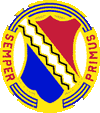
A Distinctive unit insignia (DUI) is a metal heraldic device worn by soldiers in the United States Army and is authorized for specific types of units listed in AR (Army Regulations) 670-1 and must be of a design approved by The Institute of Heraldry, U.S. Army. DUI's are authorized and prescribed for wear on the service uniforms of personnel assigned to the unit and the design is derived from the coat of arms authorized for a unit. Distinctive ornamentation of a design desired by the organization was authorized for wear on the Mess Jacket uniform by designated organizations (staff corps, departments, corps of artillery, and infantry and cavalry regiments) per General Order 132 dated December 31, 1902. The distinctive ornamentation was described later as coats of arms, pins and devices. The authority continued until omitted in the Army uniform regulation dated December 26, 1911. In 1919, expanded on the use of the coat of arms was authorized to, among other things, promote "esprit de corps" and keeping alive historical traditions. In 1921, it was approved, in principle, that regiments of the Regular Army and National Guard may wear distinctive badges or trimmings on their uniforms. This badge, taken from the units official Coat of Arms became the Distinctive Unit Insignia.
The Distinctive Unit Insignia for the 1st Infantry Regiment Coat of Arms is described as follows: A gold color metal and enamel device 1 5/32 inches (2.94 cm) in height overall consisting of a shield emblazoned: Per bend Gules and Azure, on a bend or a bendlet Argent indented of seven counter indented of the same fimbriated Sable, the shield surmounting a gold color metal oval belt with three blue enamel stripes parallel to the edges of the oval and surmounted by a plain gold color metal buckle in base and a gold color metal band on each side of the shield bearing the motto "SEMPER" on the dexter band and "PRIMUS" on the sinister band in red enamel letters. The shield, motto, symbolism and background are the same as for the Coat of Arms.
Americal Distinctive Unit Insignia (Crest)
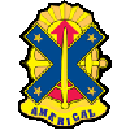
The Distinctive Unit Insignia for the 23rd Infantry (Americal) Division was approved on December 14, 1967. Called the Americal Unit Crest, it is actually a DUI as the terms have been used interchangeably since the inception of the distinguished unit insignia. On the Americal Distinctive Unit Insignia, the blue saltire (cross of St. Andrew) alludes to New Caledonia in the Southwest Pacific where the Division was created and first activated on 27 May 1942. Each of the four white stars stands for the Southern Cross constellation on its division insignia, as well as the four World War II campaigns (Guadalcanal, Northern Solomons, Leyte and Southern Philippines) in which the Division participated. The anchor refers to the Presidential Unit Citation (Navy) awarded the Division for Guadalcanal. The red arrowhead and Philippine sun stand for the assault landing, Southern Philippines, and the award of the Philippine Presidential Unit Citation (7 October 1944 to 4 July 1945). The unsheathed sword with point to top refers to Vietnam where the Division was active. In view of the Division's origin and outstanding service in World War II and inasmuch as it was one of the few U.S. Army Divisions to bear a name instead of a number, the Division's former name "Americal" has been taken as a motto, the association with that name being both inspirational and of historical military significance.
196th LIB Distinctive Unit Insignia (Crest)
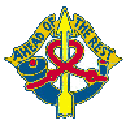
The Massachusetts origin of the 196th Light Infantry Brigade and its connection with early American history is symbolized by a blue powder horn and red carrying strap, denoting infantry and artillery, and by a yellow (for cavalry) vertical arrow from the state seal of the Commonwealth of Massachusetts.
Americal Shoulder Insignia (Patch)
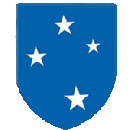
The Americal shoulder sleeve insignia is also considered a distinctive unit insignia and was originally approved for the Americal Division on 20 December 1943. The Americal was redesignated the 23d Infantry Division on 4 November 1954. On 14 December 1967 the Distinctive Unit Insignia was approved. The shoulder sleeve insignia's four white stars on a blue field are symbolic of the Southern Cross under which the organization has served. The blue color stands for infantry.
196th Light Infantry Brigade Shoulder Insignia (Patch)
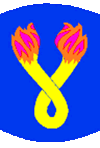
The 196th LIB shoulder patch has been generally referred to as "the burning rope"or "the double-headed match". The "double-headed match", used during the days of the matchlock musket, was tied around the solier's waist and was lighted at both ends to ensure the ability to light their crude firearms quickly. This special rope or cord was originally called a "slow match" or "match cord". The original match cords were made of hemp or flax fibers which were cheap and readily available. To ensure that the cord could burn slowly for a long time without going out, the cord was treated with lye (Potassium Hydroxide). The rope was boiled in lye for about an hour, then taken out and rinsed until the lye was washed out of the rope. Next, the rope would be treated with a saltpeter solution. The treated rope would be soaked in the solution and left for a day or so. Then the cord would be taken out and dried in the sun. A length of match cord would usually be wound a few times around a person's waist and both ends would be lit as a precaution and left to hang from the person's belt. That way, if one end was accidentally put out, it could easily be re-lit using the other end. A soldier could therefore walk around all day carrying his crude firearm and always have a source of fire ready to be used at short notice. For a complete description of the process "click here".
"Unauthorized" Patches
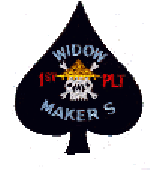
Soldiers throughout history have always found a way to do the unorthodox to suit their immediate needs. Such was the soldier in Vietnam as far as designing and procuring patches to identify their individual groups and/or situations. It wasn't hard to find a talented seamstress to put together about anything a soldier desired. Pictured is one such patch specifically designed and made for 1st Platoon, Bravo 2/1, 196th LIB. Tracking down exactly how and when this patch came existence in Vietnam has led to a dead end but, I'm fairly sure it first made it's appearance sometime in 1969. There is a page in the picture section of this site depicting some of the more colorful patches of the Vietnam era.






